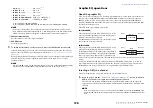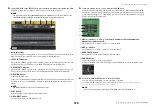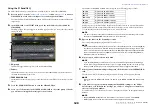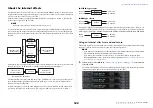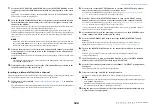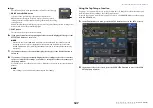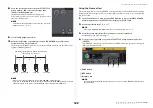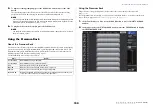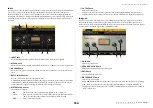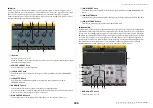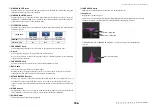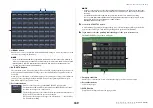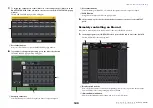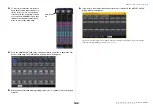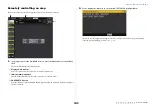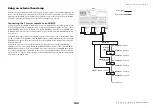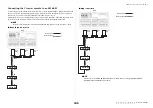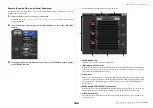
Graphic EQ, effects, and Premium Rack
Reference Manual
132
12.
Adjust the parameters.
For details on editing the parameters, refer to the next section “Editing the Premium Rack
parameters.”
NOTE
Adjust the digital gain and the processor parameters so that the signal does not reach the
overload point at the input or output stage of the processor.
13.
Using the fader of the channel you selected as the rack’s output destination in
step 6, adjust the level as appropriate.
Editing the Premium Rack parameters
Each Premium Rack window includes the following items:
1
ASSIST button
Press this button to open a window in which you can assign the parameters to the multifunction
knobs for control.
2
LIBRARY button
Press the button to open the Library popup window for Premium Rack. (For each module type)
3
DEFAULT button
Restores the default parameter setting.
4
Multifunction knob access field
Indicates the name and value of the parameters that are assigned to the multifunction knobs.
To switch the parameter to control, press the knob in the window.
NOTE
• If the ASSIST button is on, you will be able to easily identify the parameters that are currently
available for editing, and the parameters that will be available for editing after you select them.
• You can adjust the parameter in finer steps by turning a multifunction knob while pressing and
holding it down.
■
Portico 5033
Portico 5033 is a processor that emulates a 5-band analog EQ developed by Rupert Neve Designs
(RND). 5033EQ features a unique tone control response. It inherited the history of the “1073,” which
was praised as one of the greatest devices developed by Mr. Rupert Neve. Yamaha’s VCM technology
has modeled the EQ to the last detail, including the input/output transformer that was designed by Mr.
Rupert Neve himself. As a result, this processor model produces musically high-quality sound even
when bypassed. Its response features unique effects. For example, if the Lo setting is cut, the low range
becomes tight, and if the Hi setting is raised, the desired range will be boosted without hurting your
ears.
1
ALL BYPASS button
Switches EQ bypass on or off. Even when EQ bypass is on, the signal will pass through the input/
output transformer and amp circuits.
2
TRIM knob
Adjusts the input gain of the effect.
3
LF/LMF/MF/HMF/HF Frequency knobs
Adjust the frequency for each band.
4
LF/LMF/MF/HMF/HF Gain knobs
Adjust the amount of boost or cut for each band.
5
LMF/MF/HMF Q knobs
Adjust the Q (steepness) of each band. The higher the Q value, the narrower the range in which
you can control the gain for the band.
1
2
3
4
1
2
8
7
3
4
5
6

